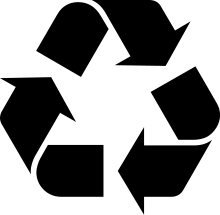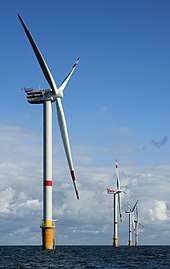Closed loop recycling
Closed loop recycling can be defined as an essential waste management for environmental protection which is a production system with recycling process.[1] The attention of strategy is shifting from disposing waste to recovery and reproduce by considering the recyclable waste as potential. Comparing to open loop recycling, closed loop recycling protects the quality loss for new product rather than the reduced functionality.[2] Also, closed loop recycling system contains various benefits that reduces the engagements of original materials and protect the environment.[3]

Purpose and Implementation
In order to obtain an equilibrium of economic growth and natural resource consumption, the resources should be utilized effectively and it requires realistic management of waste as potential. new resource[4] The closed recycling loop is formed by collecting recyclable materials, transforming into a new product and arranging the waste back into consumer circulation. It extracted post-consumer waste or byproduct of other process then recycles these items and produces into new products, such as recycling magazine or newspapers to produce other types of paper or paper-board. It also ensures the recyclable resources are valuable and they are able to be recycled and re-purposed into the same products.[1] In the economy perspective, closed loop recycling system is a sustainable concept that certain recycling and recovery measures to maintain the materials are useful as long as possible and reduce the burdens of the environment. It means the materials can be recycled indefinitely with no degradation of quality and properties, this major condition allows the recyclable product conversion of the same product as pre-consumer.[5] The most suitable materials of closed loop recycling are aluminum, glass and plastic as they will not lose the quality during the recycling and reproducing process. Furthermore, biodegradable disposal is another phase of closed loop recycling system that unrecyclable materials and byproduct which is useless in production will be break down into natural materials return to the environment without pollution and deleterious impacts.[3]
Process
Closed loop recycling technique is repeatedly recycling and reusing materials instead of down cycling, its process is to maintain material engaged in a loop arrangement to support a circular economy. Recycling and reusing throughout the whole process rather than used only once and turned into waste.[6] The principles of the process are collection, manufacturing and supplying, and the collection phase is to divert and gather recyclable materials to support the operation of the process.[2] The recycling factories obtain the resources by collecting the waste form homes, businesses and recycling banks. Further, manufacturing phase classifies recyclable materials and apply into the production of new products and the manufactures supply the new products to the third party.[2] In the management of the closed loop supply chain, the demand of products and operation efficiency is affected directly by the value of recyclable waste resources and the price strategy.[7]
| Recycling chain | |
|---|---|
| Type | Glass Plastic Potassium |
| Physical properties | |
| Density (ρ) | 2.5 kilograms per cubic meter |
Effect

Reapply and reproduce system of closed-loop recycling promotes environmental sustainability and conserve the natural resources. It minimizes the dumping of the non-degradable waste into the natural ecosystems, maximizes the value and practicality of recycling products. Moreover, the less consumption of resources decreases the risk of harm to the environment and wildlife.[8] It also enables material of high-quality to preserve in circulation ensures that there is a demand in the environment for these varieties of materials and this strategy is applied in multiple scopes. To be specific, the system reduces the application of virgin materials, saves occupancy space for non-recyclable materials, and reduces pollution in the environment as creating materials from original resources is more labor-intensive than recycling post-consumer waste and it produces more emissions.[8]
Example
Closed loop recycling strategy of environmental protection is applied in multiple range, such as fuel alcohol production, nutrient recycling from microalgae biomass as well as discontinuous carbon fiber polypropylene composites .[8] A basic example of it is the recycling of aluminum, such as cans which can be recycled and reproduced into a new can with few material degradation or waste creation. Another example is the production of plastic products which is almost 3.7 million tons each year. The grocery industry demonstrated that the consumers utilized at least 69% of produced 1 million tonnes of plastic in a year which equate to 9 billion carrier bags. In past five years, the manufactures focused on recycling plastics and the recycling rate has significantly increased. Closed loop recycling system saves 7.4 cubic yards of landfill space by recycling one ton of plastic. Hence, the closed loop recycling dramatically decreases the occupancy space, economizes the prime cost of manufacture and promote the economic efficiency.[9]
Comparison
The main differences between closed loop recycling and open loop recycling are open loop recycling requires downcycling process and applications of the materials recycled by open loop will not be the same as before recycling. Specifically, open loop recycling refers to a recycling process which the recycled materials are converted into another original materials and waste product. The reproducing process recycles the materials into another product with different purposes from their pre-recycled purpose.[2] The typical materials recycled in open recycling circulation into the recycling process as the input is converted to a new raw material, which can only be used into other manufacturing progresses. The phases of open loop recycling involve processing various similar types of products that composes and change the properties of the material itself through heating, chemical reactions, or physical crushing.[8]
However, closed-loop recycling focuses on all the materials in manufactured goods can be recycled and reused in identical role as before.[3] Closed loop recycling maintains the sustainability of supply chain and the system support the recyclable materials can be developed as the same type of products as before. Closed-loop recycling is common in specialized industries, such as the computer and battery industries which is applying expensive or complex goods that cannot easily be broken down post-consumption into constituent materials. Closed loop recycling also focuses on recycling and reusing the products without material quality loss. Therefore, closed loop recycling is more environmental friendly by comparing with open loop recycling.[3]
References
- Lamanria, F.P (2010). "Closed loop recycling:A case study of films for greenhouse". Polymar and Degradation: 285–288.
- Min, Huang (2013). "Analysis for strategy of closed-loop supply chain with dual recycling channel". International Journal of Production Economics. 144 (2): 510–520. doi:10.1016/j.ijpe.2013.04.002.
- Bruno, Lacarriere (2015). "Emergy assessment of benefits of closed-loop recycling accounting for material losses". Ecological Modelling. 315: 77–87. doi:10.1016/j.ecolmodel.2015.01.015.
- Huysman, Sofie; Debaveye, Sam; Schaubroeck, Thomas; Ardente, Fluvio; Mathieux, Fabrice; Dewulf, Jo; DeMeester, Steven (22 May 2015). "The recyclability benefit rate of closed loop recycling and open-loop systems: A case study on plastic recycling in Flanders". Resources, Conservation and Recycling. 101: 53–60. doi:10.1016/j.resconrec.2015.05.014.
- "5.2. Recycling: open-loop versus closed-loop thinking | EME 807: Technologies for Sustainability Systems". www.e-education.psu.edu. Retrieved 2019-05-16.
- La Mantia, F.P. (2010). "Closed-loop recycling. A case study of films for greenhouses". Polymer Degradation and Stability. 95 (3): 285–288. doi:10.1016/j.polymdegradstab.2009.11.030.
- Wenxue, Ran (2016). "A study of the closed-loop recycling supply chain coordination on waste glass bottles recycling". sydney.primo.exlibrisgroup.com. Retrieved 2019-05-16.
- Tapper, Rhys J.; Longana, Marco L.; Yu, Hana; Hamerton, Ian; Potter, Kevin D. (2018). "ScienceDirect". Composites Part B: Engineering. 146: 222–231. doi:10.1016/j.compositesb.2018.03.048. hdl:1983/97263ff8-0235-4a01-9df2-b186dcd230a8.
- Iqbal, Marie (2012). "Closed-loop recycling of recycled concrete aggregates". sydney.primo.exlibrisgroup.com. Retrieved 2019-05-16.


